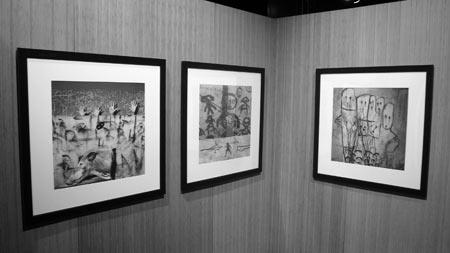New York Photo Festival: The Shows

Billed as the “Future of Contemporary Photography”, the New York Photography Festival just ended, and since I had the chance to attend the festival, I thought I’d compile my own thoughts about it. You’re probably aware of the coverage at foto8, with lots of day-to-day posts and more details that I can provide here. Given the Festival also served as some sort of photo-blogger summit (albeit unofficially), you can find snippets on lots of other blogs - there are too many to list them here (and I’d probably forget to include some of them).
The centerpiece of the Festival were four shows, one of which I already talked about (here), and there really is no need to add anything to that. The other shows were curated (and here “curated” really means “curated” and not “slapped together”) by Leslie Martin, Martin Parr, and Kathy Ryan, and it’s worthwhile to talk about them in a bit of detail.
Lesley A. Martin, book publisher at the Aperture Foundation, very kindly agreed to give me a tour of her show, “The Ubiquitous Image”, even though by the time I showed up she was already exhausted from having done that for a few hours. So thank you, Leslie, it was a real treat! This show presented the work of artists who were, very crudely speaking, working with other people’s images - and it’s very important to realize what’s going on here. There has been quite a bit of chatter about copyright on various blogs, and I often feel that such discussions get in the way of what using other people’s images actually can achieve, namely the creation of new, extremely inspiring art work.
I’m not sure Leslie would agree with the following, but in a sense, her show presented remixing in a photographic context. Take, for example, Natalie Czech’s recent work, where she assembled banners from political demonstrations (which are much more common and way more accepted in Europe), into larger images, sorted by year (for an example, see the 2001 one here). If you compare the different years, you can then literally read the trends of the years, but the images also are visually compelling. Another, completely different approach is taken by Curtis Mann, whose work I have been very fond of for quite a while now - it’s almost the exact opposite: He “destroys” photographs by (literally!) removing elements, and then new meaning (and a new aesthetic) arises from what’s left, with extremely beautiful results.
I was not taken with each of the artists in Leslie’s show - taking images of sunsets from Flickr or of TV sets from Craig’s List might be a cool idea, but I don’t see anything lasting (I’m sure other people will view the show in exactly the opposite way) - but I think Leslie has come closest to delivering on the promise of “The Future of Contemporary Photography”, by showing where extending what photography is can lead.
Martin Parr’s “New Typologies” was also an extremely nice show, with examples of artists using, well, typologies - photos of things that are very similar, yet different. Again, I thought some work was extremely good, while other work left me cold, but that’s just what one can expect (and, let’s face it, that is what makes such a show interesting - what we don’t like makes us react in ways that can actually be quite inspiring). One of the photographers whose work impressed me was Jan Banning, whose portrayal of bureaucrats in different countries nicely showed that a typology need not be something cold and unpersonal. Jan Kempenaers’ photos of weird buildings in former Yugoslavia provided maybe the opposite approach - no people, just buildings - but it also worked very well.
Kathy Ryan (photo editor of The New York Times Magazine) curated “Chisel”, and I never really figured out what that was supposed to mean. Her show was probably the most varied one, with images by Roger Ballen clashing with photos by Simon Norfolk (just as an aside, I thought Simon’s images were by far the weakest ones one could have picked from his otherwise extremely impressive body of work - especially knowing his interest in showing more than just cool images). Also included were three photos by Andreas Gefeller, which, unfortunately, were extremely badly lit, so it was almost impossible to see them properly. From what Kathy’s statement says it appears she was interested in showing in photographers “conversing with painters and sculptors”, but I’m not sure the concept worked very well.
Before I left New York, I thought that as a start this year’s Festival was quite good, but having thought about the different shows a bit more, I think I’d be happy to call the New York Photography Festival a success. Promising the “Future of Contemporary Photography” might or might not have been a bit overly confident, but showing the visions of four curators looks like a good way to disseminate contemporary photography: In the end, one’s own personal taste will always prefer this work over that work. By providing variety the Festival managed to show an outline of what contemporary photography is about: It’s extremely varied, it’s active, it likes to contradict itself, it creates extremely interesting and extremely banal work, and it lives from the many different personalities. I’m looking forward to seeing the selection of next year’s Festival - it was about time one of the hottest spots in contemporary photography, New York City, had its own photo festival!